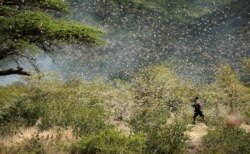Humanitarian aid work is difficult. Workers helping people without food, water, shelter, or healthcare must often face natural disasters, slow governments, and even war.
Now they have another enemy to consider -- COVID-19, the disease caused by the coronavirus. Here we will talk about three stories of humanitarian workers in hotspot areas.
Fighting locusts in Somalia
Earlier this year, Somalia faced its worst invasion of desert locusts in 25 years. In February, the country declared a state of emergency over swarms of the crop-destroying insects.
The swarms can grow to several hundred square kilometers. Each square kilometer can contain 40 to 80 million locusts. The United Nations Food and Agriculture Organization says the huge swarms can eat the same amount of food in one day as about 35,000 people.
As a child in Somalia, Mohamed Mohamud remembers the locusts. The swarms darkened the skies. The insects ate his small tomato plants – the ones he carefully grew for his family.
Today, Mohamud is an insect expert with the International Center of Insect Physiology and Ecology in Nairobi.
The center fights poverty and food insecurity by developing ways to control crop-destroying insects. To do that, it depends on equipment and people from other countries. However, now borders are closed to slow the spread of the coronavirus. So, the center can do little to help.
Mohamud told VOA that in the past when swarms became too big, helicopters would drop insect-killing chemicals. Other vehicles would also come to help. He said with COVID-19 and blockades everywhere, the situation has worsened. Movement across borders is now impossible.
Border closures between countries is one problem. There are also blocks within governmental agencies that have created other problems.
Feeding the poor in Nepal
Neera Sharma manages the World Food Program's school meal program in Nepal.
She said that the early days of the coronavirus crisis were difficult. During that four-month period, the food program changed from an in-school format to a take-home format.
The new format is based on guidelines from the World Health Organization (WHO) and instructions from the Nepalese government. But the program also needed approval from the Nepalese government and the U.S. Department of Agriculture, which helps pay for the program.
Sharma explained that in “May, June, July — three months — there was nothing.” Then, schools were closed during Nepal’s national lockdown. They were temporarily made into quarantine centers. This made giving out food even more difficult.
Sharma said that “there were countless children in Nepal” who went to school on an empty stomach.
The coronavirus has made hunger worse. The World Food Program estimates that 2.4 million children did not get necessary food when schools closed.
Civil war in Yemen
Yemen is currently experiencing what many observers say is the worst humanitarian crisis in the world.
The rainy season there is now taking place. Some people have lost their homes to flooding. These flood waters have also caused an increase in diseases, such as cholera and dengue fever.
Yemen’s civil war has continued since 2015 and it has worsened poverty.
“People in Yemen are still in need for very basic things,” said Sonia Almassad.
She manages two offices in the U.N.’s Office for the Coordination of Humanitarian Affairs, or OCHA. These basic things, she said, are water, food, shelter, blankets, and health services.
Now, Yemini people must also face COVID-19.
Humanitarian efforts in Yemen have been delayed because operations take longer now and cost more. Giving out supplies takes place over longer periods of time to permit physical distancing. People also need personal protective equipment, which raises costs.
OCHA and other U.N. agencies are struggling to find the money to continue operating in Yemen.
Since July, Almassad has been organizing all her work from her home in Syria. She did spend four months working in Yemen but was only able to move from room to room.
She said that during the disease outbreak, she has spent more time working but not getting the same results.
When will things get better?
In Somalia, Mohamud fears that heavy rains will cause another wave of locusts. His organization expects that one in every four Somalis -- 3.5 million people -- will face severe food insecurity by September.
In Yemen, three of Almassad’s U.N. colleagues recently died. The U.N. would not say if COVID-19 was the cause. Still, she expects to return to the country in the next month.
In Nepal, Sharma appeared hopeful. The school meal gave out the first round of take-home food in July. It will continue giving the 1,500 metric tons of food donated by the U.S. in a second round in late September.
The food program has done very well. So, in this year’s national budget, the Nepalese government agreed to expand coverage of the program from 60 percent of the country to 100 percent.
Sharma said “knowing that a child won’t go to bed tonight with an empty stomach because of [this] program -- that’s extremely rewarding.”
I’m Anna Matteo.
And I'm Caty Weaver.
Leslie Bonilla wrote this story for Voice of America. Anna Matteo adapted it for Learning English. Mario Ritter, Jr. was the editor.
_________________________________________________________
Words in This Story
locust –n. an insect similar to a grasshopper that gathers in huge numbers and eats crops
swarm –n. a large number of insects moving together
food insecurity –n. a household-level economic and social condition of limited or uncertain access to enough food
format –n. the way in which something is designed
lockdown –n. a situation in which people must stay in their houses or prisoners in their cells for security reasons
quarantine –n. being kept away from other people in an effort to stop the spread of a disease
round –n. one of a series of similar events or actions
rewarding –adj. giving a good feeling that you have done something valuable or important











